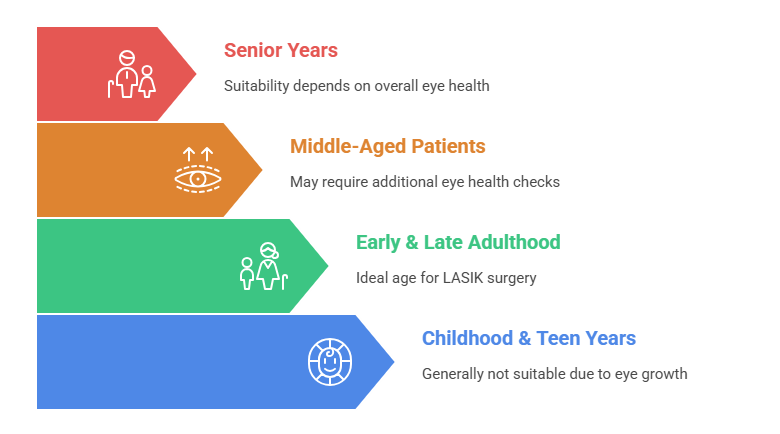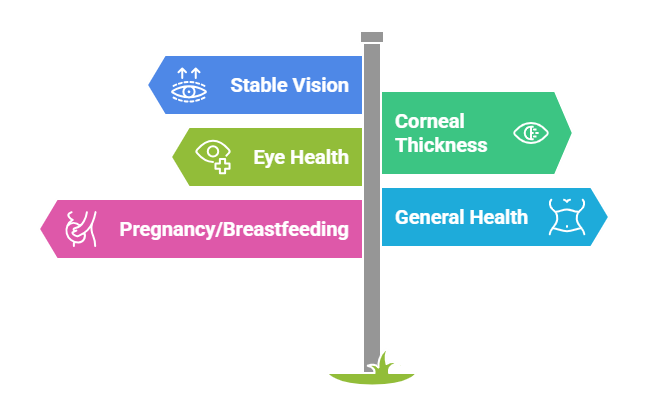
Last Updated on October 3, 2025 by Aaron Barriga
Laser-assisted in situ keratomileusis, or LASIK surgery, has gained tremendous popularity over the years. This form of refractive surgery helps to correct vision problems such as nearsightedness, farsightedness, and astigmatism.
The purpose of LASIK eye surgery is to refract or bend light rays entering the eye at a certain angle (and in a particular direction). Depending on the specifics of an eye problem, tiny amounts of tissue are removed from the cornea to give it a steeper, flatter, or more rounded curvature. This improves the way your eye focuses light onto the retina and ensures proper vision.
But is there any age limit to this surgery?
Is There an Age Limit for LASIK Eye Surgery?
There is no age limit for undergoing LASIK surgery, but you have to be at least 18 years old to get it done. The reason behind this age requirement for LASIK is that by 18, your eyes have reached physical and ocular maturity. Your cornea has stabilized to receive LASIK treatment.
That being said, you may see very few individuals at the age of 18 fully ready to receive this surgery because some still see a change in their prescription by the age of 20. Hence, doctors recommend getting LASIK after 20.
At What Age Can You Get LASIK?
Childhood & Teen Years
A child’s eye is constantly changing shape, and their vision keeps adjusting to these changes during their developing years. Their eyes are not fully developed till they reach adulthood, and any form of corrective eye surgery may only provide temporary correction of visual symptoms or issues.
In addition, LASIK is considered an elective surgery that may not be performed till the age of 18 in most cases. However, the treatment has been used to correct severe vision problems such as “lazy eye” in children and teenagers, especially when conventional treatment with glasses or contact lenses proves ineffective.
Also Read: Is LASIK Eye Surgery a Safe and Effective Option for Teens?
Early & Late Adulthood
By your late teens, your eyes have stopped growing and changing shape, and vision changes are usually minor. Still, most eye doctors suggest waiting till your mid-20s before getting eye surgery, since your prescription may still change. Generally, patients between the ages of 25 and 40 are considered to be at the ideal age for LASIK.
However, that doesn’t mean you can’t get LASIK surgery earlier. If you suffer from vision problems but have had a stable prescription for 2 years, lasik eye surgery could be the right choice. It’s also ideal if corrective glasses/lenses are impractical for your profession, e.g., working in the military, law enforcement, sports, etc.
Also Read: 6 Reasons for Millennials to Consider LASIK Eye Surgery
Middle-Aged Patients
After the age of 40, your vision may start changing again due to age-related factors. Vision correction procedures are generally preferred at a younger age, but can still be performed between 40-55 years of age depending on your medical history, eye health, and any family history of diabetes, glaucoma, or corneal diseases.
You may also face conditions such as presbyopia with advancing age, where the lens of your eye becomes rigid and you have difficulty focusing on nearby objects without reading glasses. This is a natural part of the aging process, but presbyopia cannot be treated with LASIK eye surgery.
Senior Years
There isn’t a fixed upper limit for LASIK laser eye surgery, but older patients may have age-related complications that prevent them from being good candidates. After the age of 60, you’re at higher risk for vision loss due to cataracts, and you should first get cataract surgery to replace your eye’s natural lens.
You can get LASIK even after the age of 60-70 if you have clear eyes, but other conditions such as diabetes, eye diseases such as glaucoma or corneal disease, and certain types of medication, also need to be taken into account. These may make eye surgeries such as LASIK and PRK (photorefractive keratectomy) unsuitable.
Factors That Determine LASIK Eligibility
 Age is just one factor that determines your eligibility for LASIK. Other contributing factors include:
Age is just one factor that determines your eligibility for LASIK. Other contributing factors include:
- Stable Vision: Your prescription should be steady for at least 12 months.
- Corneal Thickness: Sufficient corneal tissue is required to safely reshape the cornea.
- Eye Health: Conditions like dry eyes, infections, or injuries can impact whether you are ready for LASIK or not.
- General Health: Autoimmune diseases, diabetes, or certain medications may affect healing.
- Pregnancy or Breastfeeding: Hormonal changes can temporarily alter vision, so LASIK is usually postponed.
At InSight Vision Center, your LASIK journey begins with a detailed evaluation to assess all of these factors and determine whether LASIK is the right option for your unique eyes.
Why are There Age Restrictions for LASIK?
The entire purpose of having age restrictions for LASIK surgery is to ensure its effectiveness and safety. People who are not yet 18, or 20 for that matter, still have developing eyes. Also, they have higher chances of developing conditions that may interfere with healing after surgery or reduce LASIK’s benefits.
Moreover, while LASIK is generally considered safe and effective, there are some potential risks and complications, including:
- Dry eyes
- Halos and glare
- Undercorrections or overcorrections
Although LASIK is a safe surgery, it’s always best to consult your surgeon to analyze the benefits and risks based on your case.
Alternatives to LASIK for Younger Patients
If you are not yet eligible for LASIK, worry not. There are many other alternatives available for teens as well as young adults who still haven’t developed stable vision.
- Glasses or contact lenses remain the safest option until vision stabilizes.
- Implantable Collamer Lenses (ICLs) may be considered in select cases for adults over 21 with high prescriptions who aren’t ideal LASIK candidates.
These options can help improve vision safely while you wait for the right time for LASIK.
Also Read: ICL vs LASIK Surgery: Which One is the Best for Your Vision?
Refractive Lens Exchange (RLE): Alternative to LASIK for Older Patients
For individuals over 50, Refractive Lens Exchange (RLE) is an excellent LASIK alternative, especially if you have early cataracts or presbyopia.
In RLE, the eye’s natural lens is replaced with an artificial intraocular lens (IOL), offering clearer vision without the limitations that may disqualify you from LASIK. It also eliminates the risk of developing cataracts in the future. This surgery is particularly helpful for patients looking for a permanent solution to both distance and reading vision issues.
Also Read: Difference Between LASIK and PRK
Preparing for LASIK: What to Expect at Your Consultation
Getting ready for your LASIK can come with a mix of emotions and plenty of questions.
At InSight Vision Center, our first step toward successful LASIK surgery includes a comprehensive consultation. During this appointment, our experienced eye care team will:
- Evaluate your vision and prescription stability.
- Measure corneal thickness and eye surface health.
- Screen for eye conditions or general health issues.
- Discuss your lifestyle, vision goals, and expectations.
You’ll leave the consultation with a clear understanding of your options and whether LASIK is the right fit for you.
Schedule a Free LASIK Consultation Today!
A quick, safe, and effective solution for long-term vision correction. Schedule today and take the first step toward clearer, sharper vision.
Conclusion
LASIK can be life-changing, but the key is timing it right. While age is an important consideration, it’s just one part of the bigger picture. Whether you’re in your 20s or exploring vision correction options in your 60s, the best step forward is to consult with experienced professionals who can guide you based on your unique eye health and goals.
FAQs:
Other Important Read:
- Is LASIK Eye Surgery a Safe and Effective Option for Teens?
- Can You Get LASIK Twice?
- Does LASIK Hurt? The Truth About Lasik Eye Surgery
- How Can a LASIK Eye Surgery Procedure Help Your Eyesight?
- Can LASIK Fix Astigmatism? Is It the Best Solution?

Dr. Azhar I. Salahuddin is an ophthalmologist and is fellowship-trained in cornea, external diseases, and refractive surgery. Dr. Salahuddin has been performing cataract surgery for over 19 years and specializes ocular reconstruction, corneal transplantation surgery as well as vision correction through a variety of intraocular lenses. Dr. Salahuddin is board-certified by the American Board of Ophthalmology and was trained at Boston University.

